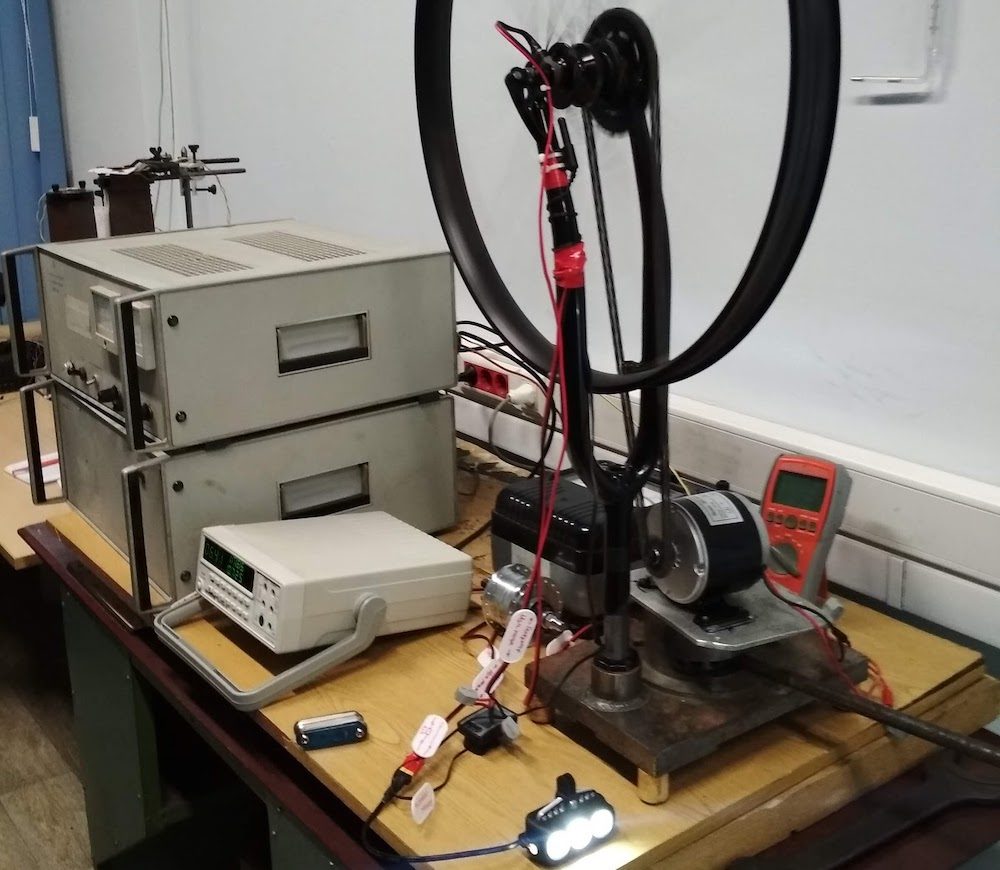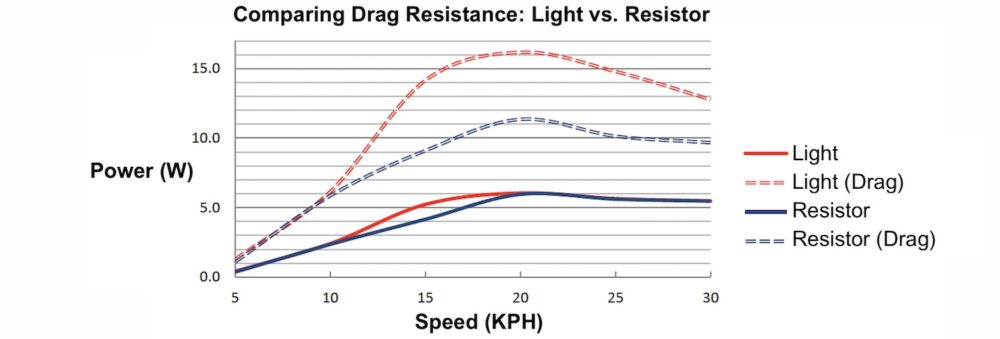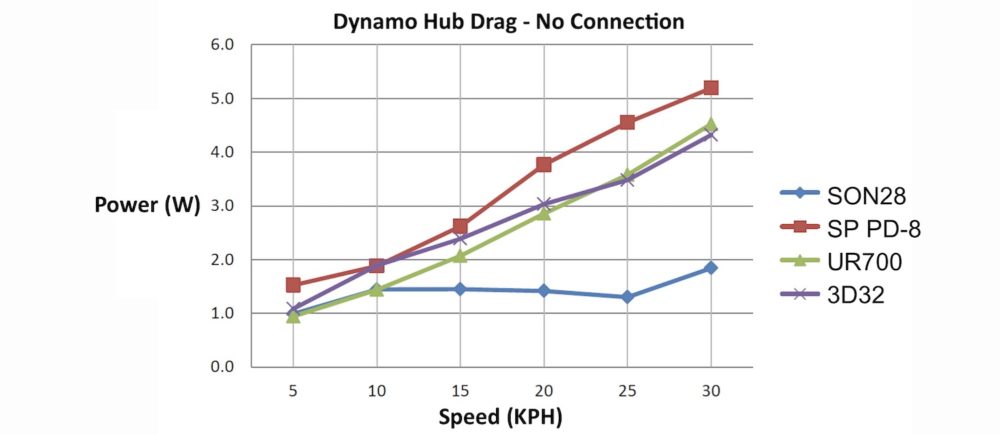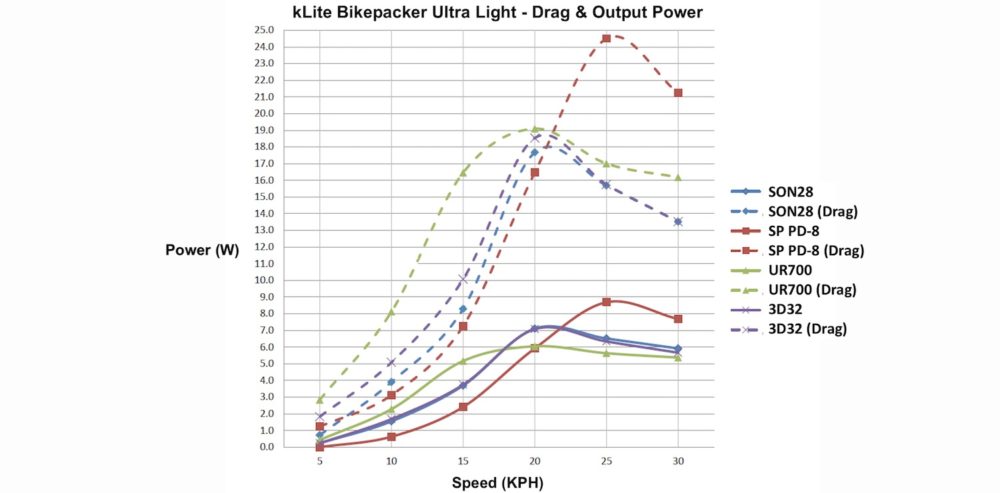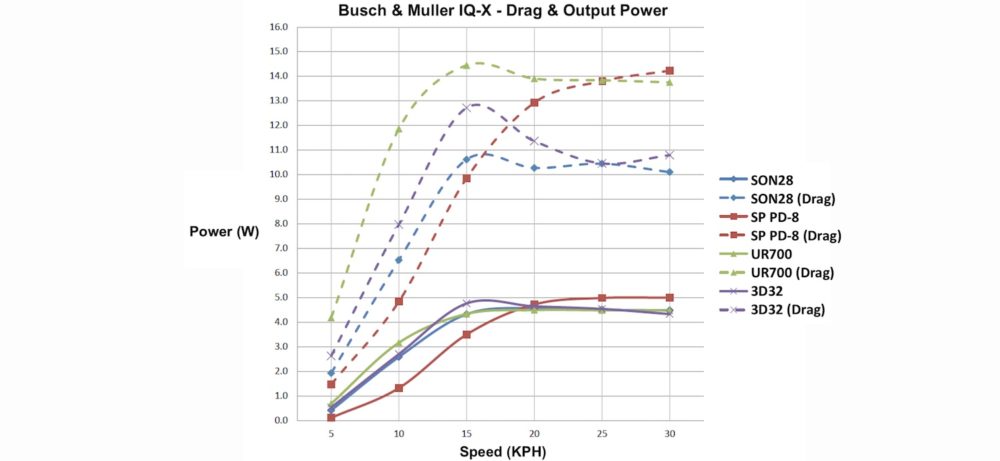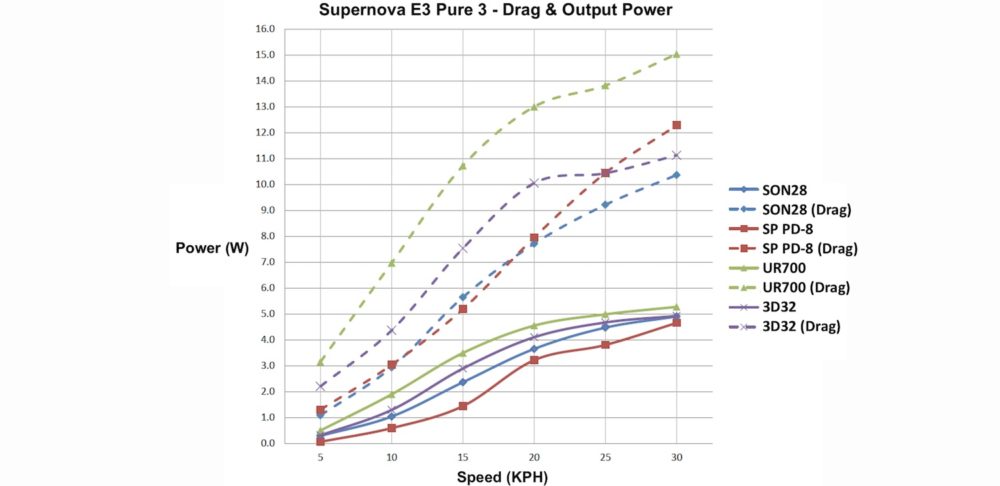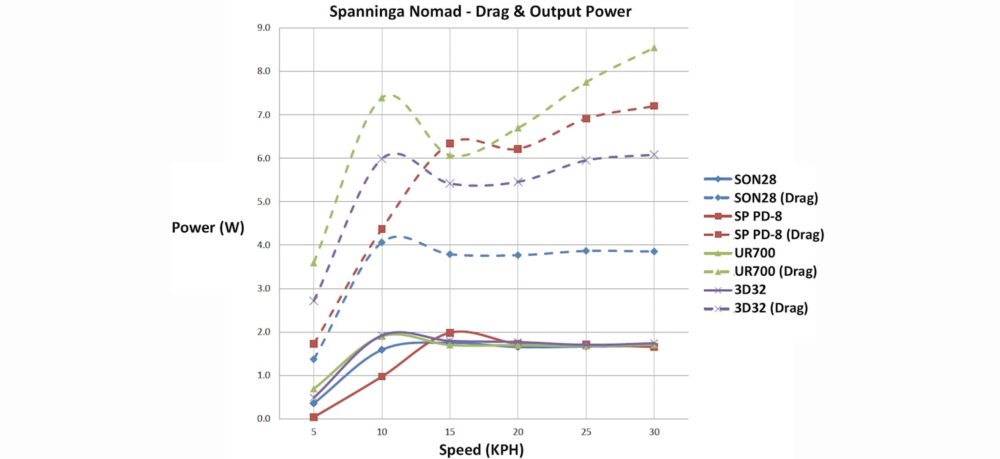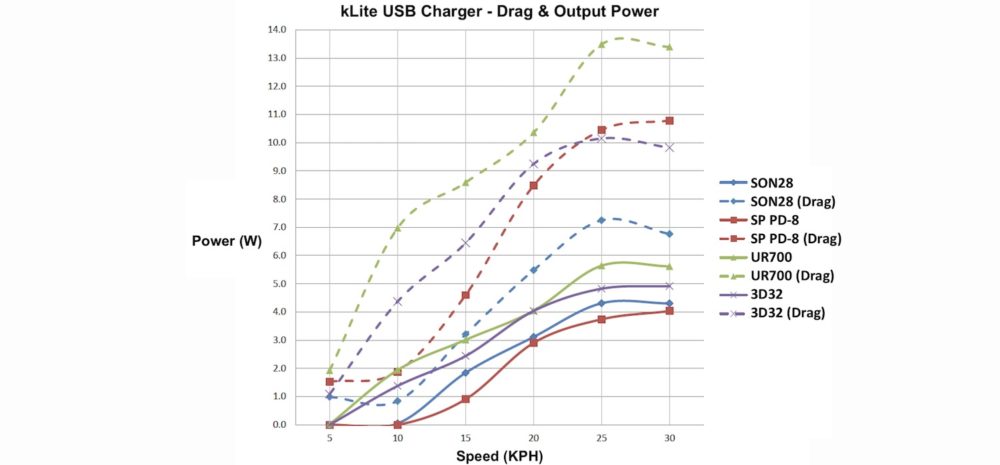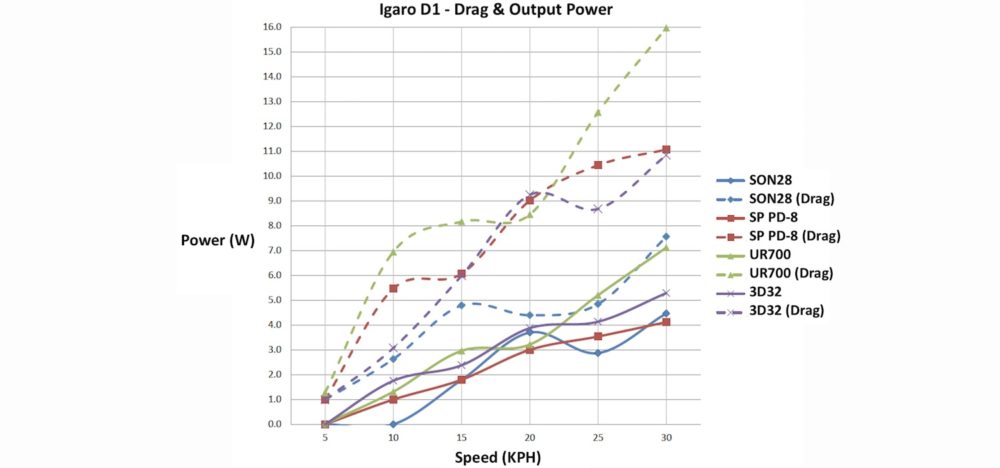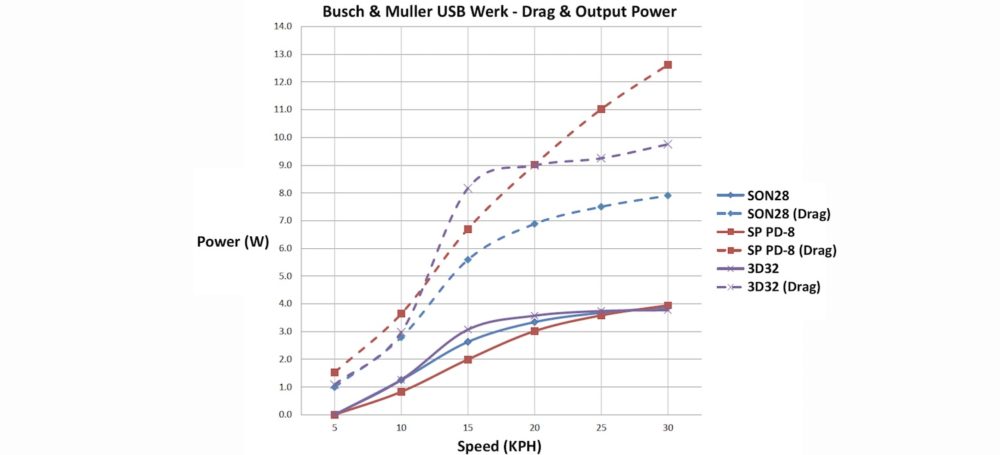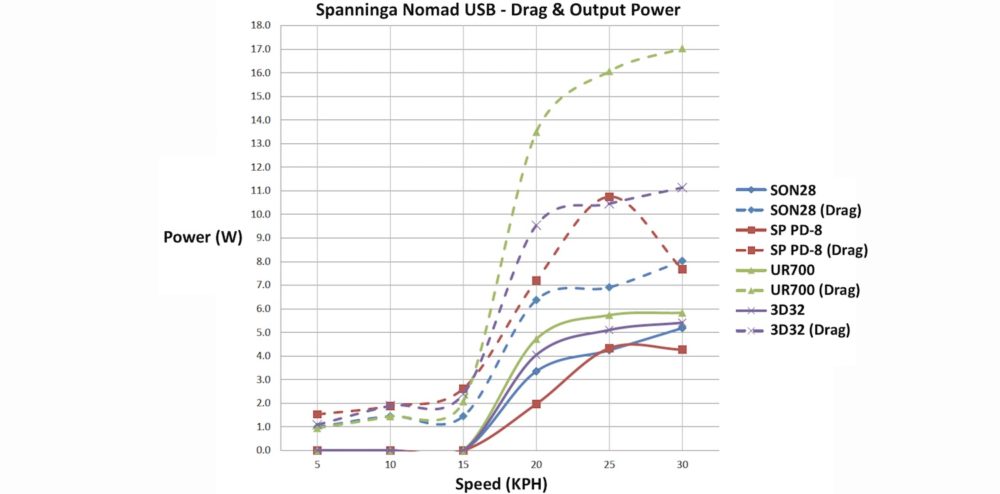Table of Contents
- The Dynamo Hubs On Test
- The Dynamo Lights On Test
- The Dynamo USB Chargers On Test
- The Lab Test
- Results: Drag Difference Between Lights & Resistors
- Results: Maximum Power Point Tracking (MPPT)
- Results: Maximum Power Point Tracking (MPPT) vs. Drag
- Results: Dynamo Hub Drag (Electronics Off)
- Results: Dynamo Hub Drag and Output Power Using Different Lights
- Results: Dynamo Hub Drag and Output Power Using Different USB Chargers
- Which Dynamo Hub Is The Best?
- Summary
I’ve written very extensively about the humble dynamo hub over the years, but new data from Skjegg Blogspot uncovers an incredible amount of extra knowledge with regards to both the output power and drag of different dynamo hubs.
This comprehensive new testing paired four dynamo hubs with different lights and USB chargers, taking measurements at speeds between 0 and 30KPH. Based on the findings, I’m very surprised to discover how different a simple 6-volt, 3-watt dynamo hub can perform.
This is going to be a technical article but stick with it if you can. The results reveal some very important information about how to best pair dynamo hubs with different dynamo lights and USB chargers.

The Dynamo Hubs On Test
The Schmidt SON28 (pic 1) hubs have always been the industry standard in terms of both efficiency and reliability. These German-made hubs are also the most expensive (US $280+); so does the performance of the hub match the price?
Shimano, who are the largest dynamo hub manufacturer in the world, recently released the Shimano DH-UR700 (2nd pic) and they’re claiming it has 44% less drag than the previous generations (no speed or resistance specified). Thanks to a new alloy axle, it weighs just 477 grams which makes it the lightest hub dynamo Shimano has ever made.
The Shimano DH-3D32 (pic 3) is an older and more cost-effective dynamo hub – in fact, you can have almost three of these hubs for the price of a SON28! The downside is that it’s 685 grams, which is almost twice as much as as the lightest hub in the test. Let’s see if it can make up for its hefty weight with a stellar performance.
The Shutter Precision PD-8 (pic 4) has grown in popularity in recent years thanks to its modest cost (US $130) and ultra light weight (it’s just 410 grams).
You can learn everything I know about dynamo hubs HERE.
The Dynamo Lights On Test
The kLite Bikepacker Ultra (pic 1) is the brightest dynamo light on the market, putting out a whopping 1300 lumens at 25km/h. There are two beam patterns available, a narrow and long beam for the road, and a short and wide beam for off-road. This handmade unit isn’t cheap (US $220), but it’s a very well-proven product in the ultra-racing world.
The Busch & Muller IQ-X is one of the brightest lights available for the road (100lux), with a near-perfect beam shape for everything but singletrack (in my opinion). It also meets the StVZO regulations in Europe so you can legally use them around the streets (basically, the light doesn’t shine oncoming people in the eyes). At US $163, it’s pricy – but hey, it has the brightest legal beam available.
The Supernova E3 PURE 3 is a beautiful German-made light. At 205 lumens it’s not the brightest, but it’s waterproof (it will literally run submerged underwater), ultra-light (90g!), has a StVZO beam and has a five-year warranty. This model doesn’t come with an on/off switch, but the E3 PRO 2 does (this is what I recommend on Amazon US $183).
The Spanninga Nomad is an ultra-cheap city light with about 40lux of light (that’s 40% the light of the IQ-X). The beam is not particularly long or bright, so it’ll be best for slower riding speeds in illuminated areas.
You can read everything about the best dynamo lights for bicycle travel HERE.
The Dynamo USB Chargers On Test
The kLite USB (pic 1) has been developed specifically for the backcountry. While not the most powerful charger available, the emphasis of this unit is on reliability. As a result, the kLite is as simple as possible, using thick internal cabling, full waterproofing and smoothing capacitors that offer ultra-consistent waveforms to your device.
The Igaro D1 (pic 2) is a discontinued dynamo USB charger from Igaro in the UK. It features a very compact size, titanium body and IP69 waterproofing – all in an ultralight package.
One of the original USB chargers is the B&M USB Werk (pic 3). It has a built-in cache battery which, for a short time, can add power to your device when going up hills or stopping at traffic lights.
The Spanninga Nomad (pic 4) is the same dynamo light as above, but the cool thing is it also has a USB charger built-in! Let’s find out if an ultra-cheap, integrated unit like this can also offer a decent charge.
You can read my detailed resource covering the best dynamo USB chargers HERE.
The Lab Test
The Skjegg test rig is essentially a fork and dynamo front wheel, which has been clamped onto a heavy steel plate. Replacing the disc rotor is a cog which connects via a chain to an electric motor mounted on the steel plate. The electric motor is then connected to a laboratory DC power source, where you can control the voltage, and therefore, wheel speed. Speed is monitored by a bike computer and the voltage is measured with a multimeter. Multiplying the readings of the devices, you can calculate the power that the engine needs to consume to spin the dynamo to the required speed. The power of headlights and USB chargers was measured to an accuracy of 0.1 W and the speed to an accuracy of 0.1KPH.
The hub drag is measured indirectly at the electric motor, rather than at the dynamo hub. To determine the dynamo hub drag, Skjegg had to first find all of the drag losses in his test rig. He used a standard bike hub to determine a baseline system drag which could then be subtracted from the drag results of the dynamo hubs (at varying speeds, with different lights and chargers connected). With the influence of slight variations in chain tension between hub tests, the drag has been measured to an accuracy of 1-watt.
It’s worth noting that this test was conducted with quick-release hubs only. Thru-axle and fat bike dynamo hubs might yield different results due to the varying magnet systems.
If you would like to read more about how Skjegg conducted their test, please go to part three of their original article HERE.
Results: Drag Difference Between Lights & Resistors
The FahrradZukunft dynamo test that I previously analysed connected an electrical load resistor (rather than a dynamo light/charger) to different dynamo hubs to find the drag. This is an ok way to benchmark different hubs against each other, but according to Skjegg, it doesn’t accurately measure the drag.
Skjegg show in the graph above how a dynamo light and resistor can consume virtually the same amount of power but have a significantly different drag. Importantly, the drag numbers you see below have been extracted from actual dynamo lights and USB chargers – not resistors.
Results: Maximum Power Point Tracking (MPPT)
Another interesting thing that Skjegg revealed was the maximum power available at different speeds from a Shimano UR700 dynamo hub. Actually, dynamo hubs will put out more power than this but this is the maximum power with the minimum drag.
Using a rheostat, the resistance was manually adjusted until the maximum power output was found at different speeds. As you can see in the graph there is a relatively large difference between the Igaro D1 USB charger output power and the MPPT of the Shimano UR700 hub (it’s often 50% more power).
MPPT of a UR700 Hub vs. Best Dynamo USB Charger Currently Available
5KPH – 1.5W (MPPT) and 0.25W (Forumslader V5)
10KPH – 2.6W (MPPT) and 1.7W (Cinq Plug5 Plus)
15KPH – 4.2W (MPPT) and 3.5W (Cinq Plug5 Plus)
20KPH – 6.0W (MPPT) and 4.8W (Forumslader V5)
25KPH – 7.7W (MPPT) and 6.5W (Forumslader V5)
30KPH – 9.1W (MPPT) and 7.4W (Forumslader V5)
Currently, the biggest areas of improvement in charging look to be found between 5-10KPH where we are only extracting 17-65% of the maximum power available from the hub. After 15KPH, we are already able to charge at 80%+ of the maximum power.
Results: Maximum Power Point Tracking (MPPT) vs. Drag
Skjegg also found the MPPT of the other three dynamo hubs. As you can see, the Shimano hubs (new and old) offer the most output power, followed by the Schmidt SON28 and SP PD-8.
He then graphed the MPPT alongside the hub drag. Shimano’s new UR700 hub can technically offer less drag than the older 3D32 despite developing more potential power – a nice update. The Schmidt SON28 offers the smallest difference between output power and drag, indicating it is the most efficient. And the SP PD-8 is the least powerful hub with a somewhat high drag, especially at speeds above 20KPH.
Results: Dynamo Hub Drag (Electronics Off)
Light/USB Switched OFF While Cycling @ 10-30km/h
Schmidt SON28 // 1.40w-1.90w drag
SP Dynamo // 1.90w-5.20w drag
Shimano UR700 // 1.40w-4.50w drag
Shimano 3D32 // 1.90w-4.30w drag
This test determines how much extra resistance your dynamo hub creates when there is nothing connected.
The drag between 5-10km/h is within 0.5-watts for all dynamo hubs, but when we hit 15km/h the differences become much more pronounced, with the highest-performing hub (SON28) running 1.1-watts less resistance than the lowest-performing (SP). The difference in drag continues to increase as the speeds get higher; the biggest difference is at 30km/h where the SON has 3.3-watts less resistance than the SP, and 2.5-watts less resistance than the Shimano hubs.
Results: Dynamo Hub Drag and Output Power Using Different Lights
Key Talking Points for the kLite Bikepacker Ultra:
– The Shimano UR700 hub provides the most light from 5KPH to 17.5KPH, with a maximum brightness at 20KPH (6-watts).
– The SON28/3D32 hubs offer the most light from 17.5KPH to 22KPH, with a maximum brightness at 20KPH (7-watts).
– The SP PD-8 hub offers the most light after 22KPH.
– Compared to the SON28, the SP offers 35% more power to the light at 25KPH.
– The drag is lowest for the SON28 at maximum power (18-watts), but not by much.
– At low speeds, the drag is considerably higher with the UR700 hub (but you get 10-25% more light).
– The drag is 24.5-watts(!) with the SP at maximum power; if you want a bright-as-hell light, you’ve gotta pedal hard for it.
– Average lighting efficiency between 10-30KPH: SON28 (42.6%), 3D32 (38.2%), PD-8 (32.7%), UR700 (31.3%).
Key Talking Points for the B&M IQ-X:
– The UR700 again provides the most light up until 12.5KPH, but it has considerably more drag too (14.5W @ 15KPH!).
– The 3D32 hub offers exceptional power at 15KPH and relatively low drag at higher speeds too.
– The SP provides the least light until 18KPH, but the most light above 20KPH.
– The SON28 offers 3 to 4-watts less drag than the SP or UR700 hubs at speeds above 20KPH.
– The drag numbers for the SP are quite high compared to the SON28 considering it’s only providing 10% more light.
– Average lighting efficiency between 10-30KPH: SON28 (42.1%), 3D32 (39.2%), PD-8 (34.0%), UR700 (30.8%).
Key Talking Points for the Supernova E3 Pure 3:
– This light is clearly optimised for speeds above 25KPH as it has pretty low power outputs at slow speeds.
– The good news is that the drag is low at slow speeds as a result of the low power outputs.
– The UR700 extracts the most out of the light at all speeds.
– At 25 to 30KPH, the SON28 or 3D32 are the best options when considering both the brightness and drag.
– Average lighting efficiency between 10-30KPH: SON28 (43.6%), 3D32 (39.7%), UR700 (33.0%), PD-8 (32.2%).
Key Talking Points for the Spanninga Nomad:
– The output power is very low, only 40% of the B&M IQ-X.
– The output power is obviously optimised for city riding, with maximum power available at 10KPH on my hubs.
– For the same brightness, the SON28 has 30-50% less drag than other dynamo hubs.
– Average lighting efficiency between 10-30KPH: SON28 (45.9%), 3D32 (31.5%), PD-8 (26.7%), UR700 (24.4%).
Results: Dynamo Hub Drag and Output Power Using Different USB Chargers
Key Talking Points of the kLite USB Charger:
– The Shimano UR700 is a great option at lower speeds, offering 1-2 watts more power than the SON28.
– The SP PD-8 requires a high average speed (18KPH) to meet the minimum charging specification for a smartphone (2.5W).
– The Shimano hubs are the only option with the kLite that can charge batteries at under 10KPH (kLite claim down to 8KPH).
– The SON28 drag is significantly lower than the SP, yet offers more power.
– Average charging efficiency between 15-30KPH: SON28 (60.2%), 3D32 (44.5%), UR700 (39.8%), PD-8 (31.9%).
Key Talking Points of the Igaro D1:
– The power and drag curves are little unusual on all but the SP PD-8 hub.
– The D1 offers exceptional charging efficiency with the SON28 at 20KPH in particular (84%!).
– The charger requires a minimum of 13KPH (UR700) to 17KPH (SP) before it will hit smartphone charging specification (2.5W).
– The Shimano UR700 can provide 2-3W extra power at 30KPH (with a lot of extra drag).
– Average charging efficiency between 15-30KPH: SON28 (59.9%), 3D32 (43.9%), UR700 (40.5%), PD-8 (33.5%).
Key Talking Points of the B&M USB Werk:
– The USB Werk requires 13KPH (3D32) to 17.5KPH (SP) to hit the smartphone charging specification (2.5W).
– Maximum power output at 30KPH varies very little, but the drag is 40% lower on a SON28 hub.
– The USB Werk looks to have been optimised for the SON28 as it offers moderate power with the lowest drag.
– Average charging efficiency between 15-30KPH: SON28 (48.5%), 3D32 (39.3%), PD-8 (31.7%).
Key Talking Points of the Spanninga Nomad Charger:
– The charger will not be very useful until 17 to 21KPH when it can hit the smartphone charging specification (2.5W).
– At speeds between 20 and 30KPH it is actually a very solid little charger, offering more power than most.
– When using the UR700 hub the drag is very high in proportion to the power output (the 3D32 would be the better buy).
– Average charging efficiency between 15-30KPH: SON28 (56.9%), 3D32 (43.6%), UR700 (38.6%), PD-8 (34.4%).
Which Dynamo Hub Is The Best?
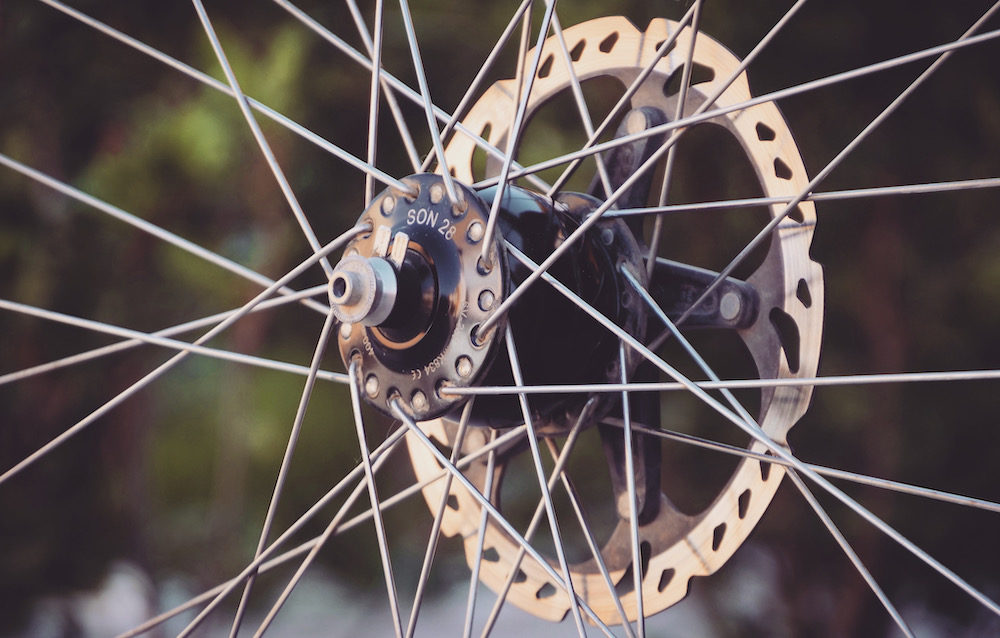
The Schmidt SON28 is incredibly efficient across the board making it the undisputable king of dynamo hubs. Despite it usually running the least amount of drag, it offers the 2nd or 3rd-most power in all cases (with ~57% efficiency on charging). Not only that, but SON28 hubs are reliable and use high-grade SKF sealed bearings to help them run smoothly for more than 50,000km. These hubs are super expensive but, in my opinion, are quite good value when you consider the performance on offer.
The Shimano DH-UR700 consistently offers the most power at speeds between 5KPH and 15KPH (3-9MPH), so it’s going to be a great option for off-road or hilly terrain. It’s also often the most powerful hub for charging devices. The only downside is the drag – the hub is powerful but slow. In fact, you’ll often find the drag is 50% less on the SON28.
Shimano UR700 Quick Release – US $152 (Amazon Special HERE)
Shimano UR705 12mm Thru Axle – US $123 (Amazon Special HERE)
The Shimano 3D32 is a $99 dynamo hub that packs amazing performance for the price. When we factor in both the output power and drag, this cheap hub ranks 2nd after the SON28 in almost all cases (~44% charging efficiency). If you are choosing between the Shimano hubs, this would be the one to pick if (a) your average speeds are higher than 18KPH and (b) you don’t mind the extra 200+ grams.
Shimano S501 Quick Release (same internal unit & performance) – US $99 (Amazon Special HERE)
The SP PD-8 offers the most power at high speeds with both the kLite Bikepacker Ultra and B&M IQ-X lights. But otherwise, the results are quite disappointing, especially when paired with a USB charger where it offers the least amount of power of all hubs and poor average efficiency of ~34%. That said, the output power and drag information are just one aspect of a dynamo hub – SP hubs are still great! They work out to be very reliable, ultra-lightweight and affordable, especially the 15mm axle version which is literally half the price of a SON28 ($185 vs $350).
Exposure Revo 15mm Thru Axle (same hub as SP) – US $185 (Amazon Special HERE)
Note: You can support this website by purchasing dynamo hubs through Amazon. I make a small commission on any sales, at no cost to you!
Summary
This data sheds a lot of light (pardon the pun) on the differences between dynamo hubs. I’m quite surprised by these results as I had no idea there was so much performance variation between hubs, in both drag and power output.
Until now, the differences between dynamo hubs have been a bit of a mystery. This is because almost all lab tests have used Schmidt SON28 hubs for power generation. In addition, previous dynamo light tests have used electrical load resistors to simulate the output power rather than actual lights. As Skjegg Blogspot have shown, there is a marked difference in hub drag when we connect a dynamo light.
The amount of drag in Shimano and SP dynamo hubs is higher than I understood it to be. Previously I have stated that dynamo hubs have a charging efficiency of between 50-60%, but this new data shows that only the Schmidt SON28 can claim that with a 57% charging efficiency. Comparatively, the Shimano hubs run between 39-44% efficiency while the SP hub works out to be 34% efficient.
Assuming you’re generating 4-watts of USB power from your dynamo hub when you use an SP PD-8 over a Schmidt SON28, you can expect more than 5-watts of extra hub drag – that’s a lot! I’ll have to write a more detailed article on how drag affects your speed soon.





